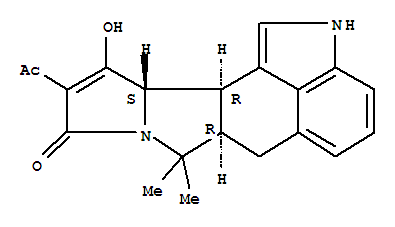9H-Pyrrolo[1',2':2,3]isoindolo[4,5,6-cd]indol-9-one,10-acetyl-2,6,6a,7,11a,11b-hexahydro-11-hydroxy-7,7-dimethyl-,(6aR,11aS,11bR)-rel- cas no:18172-33-3
Synonyms: 9H-Pyrrolo[1',2':2,3]isoindolo[4,5,6-cd]indol-9-one,10-acetyl-2,6,6a,7,11a,11b-hexahydro-11-hydroxy-7,7-dimethyl-, (6aa,11ab,11ba)- (8CI); Cyclopiazonic acid; NSC 117181; a-Cyclopiazonic acid
Name9H-Pyrrolo[1',2':2,3]isoindolo[4,5,6-cd]indol-9-one,10-acetyl-2,6,6a,7,11a,11b-hexahydro-11-hydroxy-7,7-dimethyl-,(6aR,11aS,11bR)-rel-
CAS18172-33-3
Synonyms9H-Pyrrolo[1',2':2,3]isoindolo[4,5,6-cd]indol-9-one,10-acetyl-2,6,6a,7,11a,11b-hexahydro-11-hydroxy-7,7-dimethyl-, (6aa,11ab,11ba)- (8CI); Cyclopiazonic acid; NSC 117181; a-Cyclopiazonic acid
Molecular FormulaC20H20 N2 O3
Molecular Weight336.42
refractive index1.626
storage temp−20°C
Globally Harmonized System of Classification adn Labelling of Chemicals(GHS)
Hazardclass6.1(a)
Hazard T: Toxic;
Risk R25
Safety
Poison by ingestion and intraperitoneal routes. An experimental teratogen. Experimental reproductive effects. Mutation data reported. When heated to decomposition it emits toxic fumes of NOx.
Hazard Codes:  T
T
Risk Statements: 25
R25 :Toxic if swallowed.
Safety Statements: 36/37/39-45
S36/37/39:Wear suitable protective clothing, gloves and eye/face protection.
S45:In case of accident or if you feel unwell, seek medical advice immediately (show the label whenever possible.)
| Organism |
Test Type |
Route |
Reported Dose (Normalized Dose) |
Effect |
Source |
| chicken |
LD50 |
oral |
12mg/kg (12mg/kg) |
|
Poultry Science. Vol. 65(Suppl, |
| mouse |
LD50 |
intraperitoneal |
13mg/kg (13mg/kg) |
BEHAVIORAL: MUSCLE WEAKNESS
LUNGS, THORAX, OR RESPIRATION: DYSPNEA
GASTROINTESTINAL: "HYPERMOTILITY, DIARRHEA" |
Food and Chemical Toxicology. Vol. 23, Pg. 831, 1985. |
| mouse |
LD50 |
oral |
64mg/kg (64mg/kg) |
SENSE ORGANS AND SPECIAL SENSES: PTOSIS: EYE
LUNGS, THORAX, OR RESPIRATION: DYSPNEA |
Research Communications in Chemical Pathology and Pharmacology. Vol. 55, Pg. 303, 1987. |
| rabbit |
LDLo |
intraperitoneal |
10mg/kg (10mg/kg) |
BRAIN AND COVERINGS: CHANGES IN SURFACE EEG
SENSE ORGANS AND SPECIAL SENSES: MIOSIS (PUPILLARY CONSTRICTION): EYE
LUNGS, THORAX, OR RESPIRATION: RESPIRATORY STIMULATION |
Food and Chemical Toxicology. Vol. 23, Pg. 831, 1985. |
| rat |
LD50 |
intraperitoneal |
2mg/kg (2mg/kg) |
GASTROINTESTINAL: CHANGES IN STRUCTURE OR FUNCTION OF ENDOCRINE PANCREAS
LIVER: "HEPATITIS (HEPATOCELLULAR NECROSIS), DIFFUSE"
KIDNEY, URETER, AND BLADDER: "CHANGES IN TUBULES (INCLUDING ACUTE RENAL FAILURE, ACUTE TUBULAR NECROSIS)" |
Toxicology and Applied Pharmacology. Vol. 18, Pg. 114, 1971. |
| rat |
LD50 |
oral |
36mg/kg (36mg/kg) |
BEHAVIORAL: SOMNOLENCE (GENERAL DEPRESSED ACTIVITY)
LIVER: "HEPATITIS (HEPATOCELLULAR NECROSIS), DIFFUSE"
KIDNEY, URETER, AND BLADDER: "CHANGES IN TUBULES (INCLUDING ACUTE RENAL FAILURE, ACUTE TUBULAR NECROSIS)" |
Toxicology and Applied Pharmacology. Vol. 18, Pg. 114, 1971. |
Carcinogenicity of Cyclopiazonic acid (CAS NO.18172-33-3) hasn't been listed as a carcinogen by NTP, IARC,ACGIH, or CA Prop 65. You can see actual entry in RTECS for complete information.


 T
T